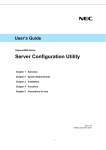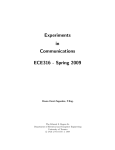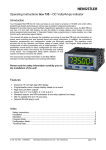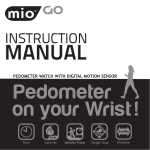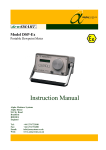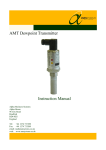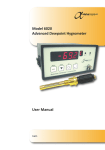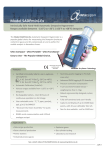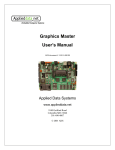Download instruction manual
Transcript
dewTEC DS2000 dewpoint meter instruction manual alpha moisture systems alpha house, 96 city road bradford, BD8 8ES england Tel: +44 1274 733100 Fax: +44 1274 733200 Email: [email protected] Web: www.amsystems.co.uk dewTEC DS2000 User’s Manual Page ii HOW TO USE THIS MANUAL IMPORTANT: USER MUST READ THIS MANUAL BEFORE OPERATING THE dewTEC DS2000 DEWPOINT METER This manual comprises of six sections viz. Section 1 General Description Includes general description outlining the main features of the unit. Section 2 Installation Instructions Safety Information Unpacking your dewTEC DS2000 and Moisture Sensor Sensor Care Sensor Installation Dew Point Meter Installation Electrical Connections External AUTOCAL Control Section 3 Operating Instructions Start Up Front Panel Display and Keys Viewing Pre-Set Parameters Alarm Settings Resetting a Latched Alarm Section 4 dewTEC DS2000 Settings AUTOCAL Factory Set Parameters Calibration Data, Analogue Output Span, Offset, Filter, Serial Communications, Display Colour, Lock, Help, Alarm Mode and Direction, Analogue Output Type, Totaliser. Section 5 RS485 Serial Communications Data Format Protocol Message Form Section 6 Maintenance and Trouble Shooting Maintenance Problem Guide Appendices Specifications and General Arrangement dewTEC DS2000 User’s Manual Page iii dewTEC DS2000 User’s Manual Page iv CONTENTS HOW TO USE THIS MANUAL iii 1.0 1 General Description & Features 1.1 1.2 Description Main Features Dewpoint Meter Features Sensor Features 1 1 1 1 Installation Instructions 2 1.2.1 1.2.2 2.0 2.1 2.1.1 2.1.2 2.2 2.3 2.4 2.5 2.6 2.6.1 2.6.2 2.7 2.7.1 2.7.2 2.7.3 2.7.4 2.7.5 2.7.6 2.7.7 3.0 9 9 10 11 12 12 Hygrometer Settings 4.2.1 4.2.2 13 Sensor Calibration (AUTOCAL) Programmed Settings Program Mode Configuration Mode 13 14 14 16 Serial Communications 5.1 5.2 5.3 5.3.1 5.3.2 5.4 6.0 9 Start Up Front Panel Display and Keys Viewing Operating Mode Parameters Setting the Alarms and hysterisis Hysterisis Operation Resetting a latched Alarm 4.1 4.2 5.0 2 2 2 2 2 3 5 6 6 6 6 7 7 7 7 8 8 8 Operating Instructions 3.1 3.2 3.3 3.4 3.5 3.6 4.0 Safety Information Warning Isolation Unpacking your dewTEC DS2000 Dewpoint Meter and Sensor Sensor Care Installing the air/gas sampling system Installing and commissioning the sensor Installing your dewTEC DS2000 Hygrometer Panel mounting cut out Panel mounting Electrical interface connections Mains (line) supply or optional DC Input Sensor Connection Alarm Relay Outputs Linear (Analogue re-transmission) Output Alarm Transistor Open Collector Outputs Serial Communications Output External Autocal Control 18 Data Format/Baud Rate Protocol Message Format Message Form 1 Message Form 2 Error Conditions 18 18 18 18 19 19 Maintenance and Troubleshooting 6.1 6.2 20 Maintenance Problem Guide 20 20 Appendices 22 Appendix A – Product Specification Appendix B – General Arrangement 22 23 Document No. 1125 Issue 4 12/01/05 dewTEC DS2000 User’s Manual Page v dewTEC DS2000 User’s Manual Page vi 1.0 General Description & Features 1.1 Description The dewTEC DS2000 is a DIN style panel mounted dewpoint meter, designed to accurately measure the dewpoint in gas or dry compressed air. The operating range of the unit is factory set to the Moisture Sensor supplied with the unit. Process moisture value in factory set units of °C, °F or PPM(V) is indicated, by the dewTEC DS2000 dewpoint meter, on a large five digit seven segment display The main external body of the Ultra High Capacitance Moisture Sensor is made of plated steel and a stainless steel filter guard protects the sensing element within it. The sensor can be located up to one kilometre away from the dew point meter. 1.2 Main Features 1.2.1 Dewpoint Meter Features The dewTEC DS2000 dewpoint meter’s main features are: • • • • • • • • • • • • 1.2.2 Display: Five large LED digits and one small LED digit, both with seven segments. Two alarm status LED’s. User programmable LED indication to display in either Green or Red and can be programmed to change colour when in alarm condition. Programmable via push button keys on front panel or PC (optional extra). Alarms: Two, independent, fully user programmable isolated relays with open collector outputs. Programmable lock out to avoid unauthorised tamper. Displays maximum and minimum values. Displays elapsed time from alarm condition. Factory set calibration data in °C, °F or PPM. Factory set current (mA) OR voltage (mV) analogue output. Isolated and user programmable to span over any range, within the overall range of the sensor. RS485 serial output with 1-99 address settings. 90 - 264V, 50/60Hz or 22-50V DC Universal input power supply. Accuracy ± 2°C dewpoint (or equivalent in other moisture units). AUTOCAL feature for automatic calibration adjustment. Sensor Features The sensor main features are: • • • • Various dewpoint ranges available. Range ident on sensor packaging. Conditioned for long term stability. Can be located up to 1km from the dewTEC DS2000 dewpoint meter, connected by a low impedance coaxial cable. ATEX Certified for use in potentially explosive areas with suitable Zener Barrier. dewTEC DS2000 User’s Manual Page 1 2.0 Installation Instructions 2.1 Safety Information Before installation please read the safety information below. 2.1.1 Warning Suitably qualified personnel must install the equipment and care must be taken, as high voltages may be present on the instrument terminals. The instrument must be mounted in a position that provides protection behind the panel to at least IP20. Local regulations regarding electrical installation should be rigidly observed. 2.1.2 Isolation The power supply terminals and associated internal circuitry are isolated from all other parts of the equipment, in accordance with EN61010-1, for connection to a category II supply (pollution degree 2). Any terminals or wiring connected to the input or output, which is accessible in normal operation, must only be connected to signals complying with the requirements for Safety Extra Low Voltage (SELV) circuits. Follow wiring instructions described later in this section. 2.2 Unpacking your dewTEC DS2000 Dewpoint Meter and Sensor Once unpacked, the items should be examined for any obvious external damage. Any evidence of damage or mishandling should be notified to your carrier immediately. The items should include dewTEC DS2000 dewpoint meter, Moisture Sensor packed in a metal canister, instruction manual, sensor connecting cable and any optional extras if ordered. The sensor is packed separately in a waterproof metal canister, with desiccant, to protect it from excessive moisture exposure during transit. The sensor should be inspected for damage then immediately stored in its canister until ready for installation. Retain the packaging for future use, ensuring the sensor canister cap is tightly screwed to preserve the desiccant. 2.3 Sensor Care Very special care must be taken not to damage the sensing element, for example by touching or making any other physical contact, as this may damage the sensing surface and render the Sensor useless. Additionally, the following guidelines should always be followed: • For any reason whatsoever DO NOT REMOVE THE SENSOR GUARD OR ATTEMPT TO CLEAN THE SENSING ELEMENT WITHIN IT. The Sensor is NOT user serviceable and does NOT contain any user replaceable parts. In the event of a problem follow the problem guide at the end of this manual. dewTEC DS2000 User’s Manual Page 2 • When not in use the sensor should always be stored in the desiccant contained metal canister. • The sensor should not be exposed to ambient conditions for considerably long periods. • Exposure of the sensor to liquid water or condensing atmospheres should be avoided. • The sensor should not be exposed to corrosive contaminants such as chlorine, ammonia or mercury vapours. These gasses will gradually corrode the sensor and cause a loss of sensitivity, hence affecting the system accuracy. • Avoid heat sources and extreme temperatures when choosing installation site • Ensure the sample gas exposed to the sensor is clean as contaminants such as oil, glycol and heavy hydrocarbons can mask the sensing element, thus affecting the system response. (If this is an issue contact your dewTEC DS2000 supplier for advice on a suitable sample system.) 2.4 Installing the air/gas sampling system The piping installation schematic diagram below shows all components, which could be used in a dry gas measurement application although not all the items shown will be required for every installation. Care should be taken to ensure that the sample presented to the measuring sensor is not contaminated with any component that will damage, contaminate or affect the sensor in a way that will impair the system accuracy. It is strongly recommended that the sample should not contain particulate matter, oil or other heavy hydrocarbon condensate. If these components contaminate the sample system and/or the measuring sensor, the system response time will be lengthened, although the sensor calibration will not be effected. The sample must not contain Ammonia, Chlorine, Ozone or any wet acid vapours or liquid as these will permanently damage the sensor and impair calibration accuracy. The flow rate, although not critical to the sensor measurement, should be low enough to avoid abrasion to the sensor surface without being so low as to extend the system response time to an unacceptable level. In general, a flow rate of between 2 and 3 litres/min at NTP will give the right balance. The sensor is a variable capacitor, which is directly affected by changes in partial pressure of water vapour, and these changes, that are proportional to the dew/frost point temperature, are displayed on the hygrometer display. The measuring sensor can be installed directly into the process line but this does create problems with access for maintenance and calibration. It is for these reasons that we recommend that the sensor be installed in a bypass, fast loop or total loss sample system where the sensor is accessible without interrupting the main process flow line. dewTEC DS2000 User’s Manual Page 3 Piping installation Schematic 4 A 5 7 6 P 2 1 0 1 1 4B 9 3 1 Main Proces s Li Notes a. b. 8 The sample point should be on the upper surface of the horizontal pipe, or from a vertical section of pipe, wherever possible. The sample tube should run upwards from the sample point. If this is not possible, then an inspection port or drain tap should be installed at the lowest point in the sample system. Piping Schematic Component Index 1) Sample Isolation Valve - This is a recommended item as it allows access to the sample system without interrupting the main process line. 2) Sample Tube – This should be stainless steel for dry air or gas applications but copper or carbon steel can be used where wetter gases are to be measured. If any section of the sample tube must be flexible then PTFE should be used. In most cases, 3mm OD (1/8”) is sufficient as it provides good system response time within minimum flow. 6mm OD (1/4”) tube can be used where pressure drops across the 3mm tube are too high 3) Filter Unit – A filter unit is recommended when the samples are likely to contain particulate matter. If the air/gas sample contains heavy hydrocarbon condensate, the filter must be of the coalescing type with a drain. The filter unit should be positioned as close to the sample point as practical. dewTEC DS2000 User’s Manual Page 4 4) Pressure Reduction Valve or Pressure Regulator – If the sample is to be measured at atmospheric pressure then the valve 4A should be fitted and 4B omitted from the system. If the sample is to be measured, at full line pressure and the exhaust vented to atmosphere, then valve 4B should be fitted and 4A omitted from the system. If measurements are to be taken at full line pressure and the sample is to be returned to a part of the main line or a vent, which is at a pressure higher than atmospheric, and the input to that line needs a controlled pressure then both 4A and 4B will be required. 5) Sample Pressure Gauge – This is not a critical part of the moisture measurement but may be required if Dew/Frost point measurements are to be made at higher than atmospheric pressure. 6) Measuring Sensor. 7) Sensor Holder. 8) Desiccant Chamber – This item is required when the sampling is to be intermittent. When installed it prevents the ingress of wet air to the sample system, while the sample is not flowing, improving the response time. 9) Flow Control Valve – This can be a separate item or combined with the flow indicator. 10) Flow Indicator – The recommended sample flow is 2 to 3 SL/M. Sample Exhaust – The exhaust can be vented to atmosphere or returned to the process line as discussed above. 2.5 Installing and commissioning the sensor It is advisable to carry out an initial purge routine of the sample loop, before installing the sensor, in order to remove the possibility of sensor damage on start-up. Referring to the sample system schematic in section 3.4, open the inlet isolation valve slowly, until a small flow of air/gas at atmospheric pressure flows through the inlet pipe work to the sensor holder and exhausts through the sensor entry port of the sensor holder. Allow this purge to continue for about 15 to 20 minutes to remove any residual moisture from the sample pipe work and components. Close the inlet isolation valve and install the sensor into the sensor holder. Securely push fit the coaxial sensor cable connector in position on the sensor. Open the inlet valve slowly, again and, by opening all valves after the sensor holder, allow a low-pressure purge through the whole sample system. (Note. If a closed by-pass loop is installed, this section of the procedure is not possible). Set the required pressures and flows within the sample loop. This completes the installation and commissioning but, on initial start-up, it could take several hours for the system to reach equilibrium. dewTEC DS2000 User’s Manual Page 5 2.6 Installing your dewTEC DS2000 Hygrometer The dewTEC DS2000 is a standard 1/8th-DIN size. 2.6.1 Panel mounting cut out The panel on which your hygrometer is to be mounted must be rigid and up to 6mm thick. The cut out size required is shown in the diagram below. 92.00mm +0.5 | 0.0 2.6.2 Panel mounting Your hygrometer is supplied with a panel gasket and push-fit fixing strap. Do not remove the panel gasket, as this may result in inadequate clamping of the hygrometer in the panel. Remove the push-fit fixing strap and place the hygrometer through the cut out from the front. Then slide the fixing strap over the hygrometer housing from the rear of the panel until the tongues engage in the ratchets and hygrometer is firmly in place. 2.7 Electrical interface connections The rear terminal houses all connections to the unit. The connections are shown in the diagram below and each input is described further in the following paragraphs. See the full specification given at the end of this manual for more details on the interfaces. POWER SUPPLY 22 – 55V DC 5W + OR 50/60Hz 7.5VA L 100 – 240Vac - RS485 COMMS B N A RELAY1 COM N/C COM N/O Relay Contacts 2A Resistive 110 - 240V ac 13 14 15 16 17 18 19 20 21 + 12 TOP 11 - Sensor Connector 10 9 8 7 NPN COM NPN O/P1 O/P2 dewTEC DS2000 User’s Manual 6 5 4 3 2 22 N/C 23 COM 24 N/O 1 INTERNALUSEONLY Page 6 2.7.1 Mains (line) supply or optional DC Input The hygrometer will normally operate on 90-264V AC, 50/60Hz mains (line) voltage. The power consumption is 7.5VA. When the Optional DC version is used, the operating voltage is 22 – 55V. The power consumption is 5W. An external fuse and a suitable switch or circuit breaker must protect the mains supply of the hygrometer, which should be near the unit. Use a 1A antisurge Fuse (315mA for 24V DC option). RECOMMENDED POWER CONNECTION L 13 N 14 Fuse 100-240Vac 50/60Hz - 1A antisurge If the relay outputs are to be used to carry mains (line) voltage, it is recommended that the relay mains (line) supply should be switched and fused in a similar manner but should be separate from the hygrometer mains (line) supply. 2.7.2 Sensor Connection The sensor is connected to the hygrometer with the low impedance co-axial cable provided. This low impedance cable may be up to 1 km long. Note that the body of the sensor is not isolated. It is important that the earth potential at the sensor is the same as that in the power supply earth to avoid stray pick-up. This is very rarely a problem, but if in doubt, check for a voltage between the sensor body and the sensor holder before installing the sensor. 2.7.3 Alarm Relay Outputs The relay outputs of Alarm 1 and 2 are single pole double throw contacts rated at 2A resistive at 120Vac or 240Vac, 50/60Hz. The relay contacts are inherently isolated from the instrument and from each other. 2.7.4 Linear (Analogue re-transmission) Output A 10-bit analogue signal representing the dewpoint is re-transmitted by the output, which is factory preset to voltage or current output. The range of re-transmission can be set to anywhere within the hygrometers’ operating range. See section 4 on how to set your options. The output is isolated from the rest of the unit and should be wired using a twisted pair or screened wire. Load Impedance is 500Ω maximum in mA ranges and 500Ω minimum in voltage ranges. dewTEC DS2000 User’s Manual Page 7 2.7.5 Alarm Transistor Open Collector Outputs The open collector outputs of Alarm 1 and 2 are NPN outputs. The return is common for both collectors. 2.7.6 Serial Communications Output The cable used should be suitable for data transfer at the selected rate (1200, 2400, 4800 or 9600) over the required distance. Transmitters/receivers conform to the recommendations in the EIA Standard RS485. The “A” terminal on the hygrometer (Terminal 17) should be connected to the “A” terminal on the master device; the “B” terminal on the hygrometer (Terminal 16) should be connected to the “B” terminal on the master device and the “Common” terminal on the hygrometer (Terminal 18) should be connected to the “Common” terminal on the master device. Where several hygrometers are connected to one master port, the master port transceiver in the active state should be capable of driving a load of 120kΩ per indicator. The masterport transceiver in the passive state must have pull-up/pull-down resistors of sufficiently low impedance to ensure that it remains in the quiescent state whilst supplying up to ±100µA each to the hygrometer transceivers in the high impedance state. 2.7.7 External Autocal Control An external autocal potentiometer can be added to control the setting remotely. Connect a 2kΩ multi-turn potentiometer (20 turn or better) using a twisted pair or screened cable between pins one and three. Wire the external potentiometer to increase resistance when turned clockwise (Increasing the resistance will increase the display value). Note, to use the external control, the internal control on the rear terminal needs to be turned fully clockwise (see section 4). Twisted pair or screened cable 1 2 3 dewTEC DS2000 User’s Manual 2kΩ Page 8 3.0 Operating Instructions This section covers day-to-day operation of the dewpoint meter. 3.1 Start Up On power up, with the sensor connected, the unit will display the process value in dewpoint (or PPM(v) if factory preset). Typical warm up time is 3 minutes. 3.2 Front Panel Display and Keys ON when Alarm 1 is active Primary Display ON when Alarm 2 is active Secondary Display Down key Scroll key Key / Display / Indicator Program key Reset key Function Normally displays the process Dewpoint/Moisture value. Operational programmed parameters can be viewed by pressing the Programme key (P). The display will indicate the parameter description for three seconds before showing the parameter value. (Note: this function will only operate if the Help Facility is enabled - see section 4, Dewpoint Meter Settings). This single character identifier highlights the parameter value being displayed not lit when normally displaying the process Dewpoint/ Moisture value. Primary Display Secondary Display Down key ( ) Scroll key ( ) Program Key (P) Reset Key (R) Down and Scroll Keys ( )&( ) ALM 1 and ALM 2 In Edit Mode, decrements the flashing/blinking digit in the Primary Display. Puts the Dewpoint meter into Edit Mode. In Edit Mode this key selects the digit to be altered in Primary Display - digit selected for alteration flashes/blinks. Selects parameter to be viewed/edited. In Edit Mode this key confirms edited parameter value. When in normal display mode, pressing this key resets a latched alarm condition. Also resets the Maximum (High) Value, Minimum (Low) Value or Alarm1 Elapsed Time, whichever parameter is displayed, When pressed simultaneously in Edit Mode, the unit will abort the Edit operation and will restore the parameter to its initial value. LED Indicators lit (in all operation modes) when in alarm condition. dewTEC DS2000 User’s Manual Page 9 3.3 Viewing Operating Mode Parameters The flow diagram below shows the viewable parameters that are scrolled through as the program key (P) is pressed: Initial Display at Start Up. Displays your process Dewpoint. DEWPOINT P ALM 1 ALM 1 ALM 2 ALM 2 R P dewTEC Model DS2000 DEWPOINT METER PRESS Maximum (High) Dewpoint since last reset. To reset, press the (R) key when displayed. PRESS Maximum (High) value P ALM 1 ALM 1 ALM 2 ALM 2 R P dewTEC Model DS2000 DEWPOINT METER PRESS ALM 1 Minimum (Low) value P ALM 1 ALM 2 ALM 2 R P dewTEC Model DS2000 DEWPOINT METER PRESS ALM 1 Alar m 1 Elapsed Time P ALM 1 ALM 2 ALM 2 R P dewTEC Model DS2000 DEWPOINT METER PRESS Alar m 1 value P ALM 1 ALM 1 ALM 2 ALM 2 R P dewTEC Model DS2000 DEWPOINT METER PRESS Alar m 1 Hyster isis value P ALM 1 ALM 1 ALM 2 ALM 2 R P dewTEC Model DS2000 DEWPOINT METER PRESS Alarm 2 value P ALM 1 ALM 1 ALM 2 ALM 2 R P dewTEC Model DS2000 DEWPOINT METER PRESS ALM 1 Alar m 2 Hyster isis value P ALM 1 ALM 2 ALM 2 R P dewTEC Model DS2000 DEWPOINT METER Display change due to key activity dewTEC DS2000 User’s Manual PRESS ALM 1 ALM 1 ALM 2 Total P dewTEC Model DS2000 DEWPOINT METER Automatic display change if there is no key activity after 3 seconds R dewTEC Model DS2000 DEWPOINT METER PRESS Total value based upon integration of the input signal using the time base set in the hygrometer settings. R dewTEC Model DS2000 DEWPOINT METER PRESS Defines the width of the hysterisis band in dewpoint applied on the ‘safe’ side of the Alarm 2 level. Set in the same manner as Alarm value. R dewTEC Model DS2000 DEWPOINT METER PRESS Dewpoint at and above which (Process High Alarm) or at and below which (Process Low Alarm) Alarm 2 is active. To set press ( ) when displayed and follow the instructions given in paragraph 3.4. R dewTEC Model DS2000 DEWPOINT METER PRESS Defines the width of the hysterisis band in dewpoint applied on the ‘safe’ side of the Alarm 1 level. Set in the same manner as Alarm value. R dewTEC Model DS2000 DEWPOINT METER PRESS Dewpoint at and above which (Process High Alarm) or at and below which (Process Low Alarm) Alarm 1 is active. To set press ( ) when displayed and follow the instructions given in paragraph 3.4. R dewTEC Model DS2000 DEWPOINT METER PRESS Accumulated time that Alarm 1 has been active since last reset. This display format is in mm.ss up to 99 minutes and 59 seconds, after which the format changes to mmm.s. To reset, press the (R) key when displayed. R dewTEC Model DS2000 DEWPOINT METER PRESS Minimum (Lo) Dewpoint since last reset. To reset, press the (R) key when displayed. R dewTEC Model DS2000 DEWPOINT METER ALM 2 R P R dewTEC Model DS2000 DEWPOINT METER PRESS PRESS NOTE: These displays will not appear if the Help function is disabled Page 10 3.4 Setting the Alarms and hysterisis Note, Alarm settings cannot be changed if the alarm LOCK is enabled in the hygrometer program settings. Edit mode for Alarm 1, Alarm 2 and hysterisis settings can be entered by pressing the scroll key ( ) when the parameter is displayed. This is the first step shown in the flow diagram below. Follow the rest of the steps shown in the diagram to set your required valve. 1 Select required alarm or hysterisis parameter display. See paragraph 3.3. 2 A LM 1 A LM 2 P R ALM 1 A LM 1 A LM 2 ALM 2 P P R R Left-most digit flashes PRESS 3 P PRESS ALM 1 A LM 1 ALM 2 A LM 2 R P R Use the Down key to change value of flashing digit if required 4 P ALM 1 A LM 1 ALM 2 A LM 2 R P Note: if in edit mode no key activity occurs for 90 seconds, the hygrometer automatically returns to operation mode at the point where the setting mode was entered and cancels any changes made. R Next digit flashes PRESS 5 Repeat steps 3 and 4 for each digit required 6 When adjustment is complete, confirm new value by pressing (P). ALM 1 ALM 2 P R All digits will stop flashing and new valve will be displayed. PRESS Display is now back in operating mode at the point where the setting mode was entered. P ALM 1 ALM 1 ALM 2 ALM 2 R P R To abort at any stage. PRESS dewTEC DS2000 User’s Manual Page 11 3.5 Hysterisis Operation Operation of the hysterisis depends on whether the alarm is set to trip on high or low. The diagram below shows how the hysterisis functions in each mode. Dewpoint PROCESS HIGH ALARM Alarm value Alarm Hysterisis Alarm inactive PROCESS LOW ALARM Alarm active Alarm Hysterisis Alarm inactive 3.6 Alarm inactive Alarm value Alarm active Alarm inactive Resetting a latched Alarm If Alarm 1 is configured to be a latching alarm relay when it is active, it can be reset as follows: 1 Ensure Dewpoint is displayed 2 Press reset key (R) Note, the latched alarm cannot be reset whilst the alarm condition persists. dewTEC DS2000 User’s Manual Page 12 4.0 Hygrometer Settings 4.1 Sensor Calibration (AUTOCAL) One of the most valuable advantages of the sensors is the Autocal feature. The system relies on the fact that each sensor is designed to vice no further increase in reading when it reaches its maximum moisture level. This means that the sensor will read its maximum value when it is exposed to gas or air that is at that level and will continue to read that value when it is exposed to wetter gas. The system can therefore be calibrated to the analyser, on site, very simply by exposing the sensor to anything wetter than the maximum level and adjusting the reading to the maximum dewpoint, on the hygrometer display, using the Autocal Control on the hygrometer rear panel. L B N A COM N/C COM N/O 13 14 15 16 17 18 19 20 21 + - 12 TOP 22 N/C 11 23 COM 24 N/O Sensor Connector 10 9 8 7 6 5 NPN COM NPN O/P2 O/P1 4 3 2 1 Autocal Control Factory calibration is performed by comparing readings given from the hygrometer with readings obtained from a primary standard, traceable to The British Standard moisture generator held at the National Physical Laboratory. These comparative readings are taken after the sensor has been set to automatic calibration and the results are shown in the calibration certificate supplied with each sensor. To autocal the sensor, follow these simple steps: 1. Disconnect the coaxial cable from the sensor. Remove the sensor from its normal position so it is exposed to ambient air or hold in the palm of the hand if the sensor full range is +20ºC dewpoint. 2. Leave the sensor for approximately five minutes (this time is not critical but the hygrometer reading should be stable before any adjustment is made. It is not advisable to leave the sensor exposed to ambient air for more than a few minutes as this will impair dry-down when the sensor is re-installed). 3. IF NECESSARY, adjust the Autocal control, on the analyser front panel, until the display indicates the maximum level for the sensor range in use. dewTEC DS2000 User’s Manual Page 13 4. Disconnect the coaxial cable and re-install the sensor in its normal position. Reconnect the coaxial cable. This procedure re-confirms that the sensor is correctly calibrated to the hygrometer. We recommend that verification of the overall linearity of calibration of the system should be carried out on a 12 monthly basis. 4.2 Programmed Settings The dewTEC DS2000 has two setting modes that modify the hygrometers’ operation. The modes and parameters are shown in the following table: MODE Program Mode Configuration Mode PARAMETER Calibration Data, Decimal Point Position, Linear Output scaling, Offset, Filter, Communications address and baud rate, Display Colour, Lock, Help on/off Alarm Mode, Alarm Direction, Linear Output type, Totaliser Enter the mode that you require as described in this section to change a parameter. NOTE: Many of the parameters are factory set during manufacture, test and calibration. Do not change any of these settings as your hygrometer may give erroneous readings without you knowing. 4.2.1 Program Mode To enter Program Mode (and to exit Program Mode) Press and hold (P) for 3 seconds In program mode, the secondary display flashes continuously and shows a single character, which identifies the displayed parameter. Once in Program Mode, follow these instructions to view and set parameters: • Press (P) to scroll through the program mode parameters (as described in paragraph 3.3 for the operating parameters). • To edit any displayed parameter, press ( ) to enter edit mode and ( ) to decrement any digit (as described in paragraph 3.4 for setting the alarms). dewTEC DS2000 User’s Manual Page 14 The following table gives the program mode parameters and their sequence. Primary Identifier Display (Flashing) Description Adjustment Range STATUS Scaling Point 1. The first sensor input value point 0.00% to Factory setting. (expressed as a percentage of input span) which is 100.00% of Do not change. used to establish a curve for scaling sensor input input span values into engineering unit values (°C or °F) Display Point 1. The engineering unit value -19999 to Factory setting. corresponding to Scaling Point 1. 19999 Do not change Scaling Point 2. The first sensor input value point 0.00% to Factory setting. (expressed as a percentage of input span) which is 100.00% of Do not change used to establish a curve for scaling sensor input input span values into engineering unit values (°C or °F) Display Point 2. The engineering unit value -19999 to Factory setting. corresponding to Scaling Point 2. 19999 Do not change The scaling process can be continued up to 10 Scaling Points and 10 Display Points, until a scaling point is given the value 100.0%. This will be the final scaling point offered. Note, the hygrometer only allows Scaling Point 1 ≤ Scaling Point 2 ≤ Scaling Point 3 etc. Decimal Point Position. Defines the decimal point 0 to 0.0000 Factory setting. position for the dewpoint display and alarm values. Do not change Re-transmission Scale Minimum. The lower end of -19999 to the linear scale for the re-transmission output, 19999 User adjustable expressed as the value corresponding to the setting. minimum output signal. Re-transmission Scale Maximum. The upper end of -19999 to the linear scale for the re-transmission output, 19999 User adjustable expressed as the value corresponding to the setting. maximum output signal. Offset. Offsets the input by a fixed amount. -19999 to Not normally 19999 required. Input Filter Time Constant. Filters the input over a 0.0 (OFF) to Normally set to user definable time period to minimise the effect of 100.0 zero. User noise and impulses settable in noisy environments Communication Address. The unique serial 1 to 99 User adjustable communications address of the hygrometer setting. Baud Rate. Serial Communications speed 1200, 2400, User adjustable 4800 or 9600 setting. Display Colour Change. Defines the colour of the Red primary and secondary displays prior to/after the Green User adjustable Green to alarm level is reached setting. Red Alarm Lock. Enables/Disables the changing of alarm settings via the front panel. Help Prompt. Determines whether the Primary Display shows the parameter description for 3 seconds before a parameter value is shown. Red to Green Enabled Disabled Yes No User adjustable setting. User adjustable setting. Remember that if Help is enabled, the Primary Display shows the Displays given above and the parameter value after three seconds. dewTEC DS2000 User’s Manual Page 15 4.2.2 Configuration Mode To enter Configuration Mode (and to exit Configuration Mode) Press and hold ( ) and (P) simultaneously for 3 seconds In configuration mode, the secondary display flashes continuously and shows a single character, which identifies the displayed parameter. Once in Configuration Mode, follow these instructions to view and set parameters: • Press (P) to scroll through the configuration mode parameters (as described in paragraph 3.3 for the operating parameters). • To edit any displayed parameter, press ( ) to enter edit mode and ( ) to decrement any digit (as described in paragraph 3.4 for setting the alarms). The following table gives the parameters and their sequence. Primary Identifier Display (Flashing) Description STATUS Adjustment Range Display Description Input Range Sensor Power Supply Frequency (only needs to be set for optional DC input instrument) 50Hz 60Hz Factory setting. Do not change Automatically set for mains powered instruments. Process High Alarm 1 Type. Alarm 2 Type. Defines the action of Alarm 1 Defines the action of Alarm 2 Output 1 Direction. Determines how NPN Output 1 and Relay 1 operate dewTEC DS2000 User’s Manual Process Low User adjustable setting No Alarm Process High Process Low User adjustable setting No Alarm Alarm 1 non-latching, direct action Alarm 1 non-latching, reverse action Alarm 1 latching, direct action Alarm 1 latching, reverse action Logical OR Alarms 1 & 2, direct action Logical OR Alarms 1 & 2, reverse action User adjustable setting Page 16 Output 1 Direction. Determines how NPN Output 1 and Relay 1 operate Re-transmission (Linear) Output Alarm 2, direct action Alarm 2, reverse action Logical OR Alarms 1 & 2 direct action Logical OR Alarms 1 & 2 reverse action User adjustable setting None 0 – 5V Selects the output range. NOTE; The hygrometer is factory set to give either voltage or current outputs. See the specification sheet and your order for your hygrometer setting. Communications Enable/Disable 1 – 5V User adjustable setting 0 – 10V 2 – 10V 0 – 20mA 4 – 20mA None/Disabled Comms. Enabled Only disable this function if comms. is giving you a problem. Totaliser Timebase. Not available User adjustable setting Not available Seconds Minutes User adjustable setting Hours dewTEC DS2000 User’s Manual Page 17 5.0 Serial Communications The Serial Communications Port is a standard RS485 communications link. Up to 32 standard RS485 loads may be present in a single loop on this link. 5.1 Data Format/Baud Rate Data is format as a 10-bit data word i.e. and Supported Baud Rates are 1 7 1 1 Start bit Data bits Parity bit (even parity) Stop bit 1200, 2400, 4800, 9600 bits/second The half-duplex line turn-round time is fixed at 6ms regardless of baud rate. The maximum inter-character delay is 120ms. The No Reply timeout is 2 seconds. 5.2 Protocol The protocol operates on a single master basis. The master device initiates all communication. The hygrometer acts as a slave device. 5.3 Message Format Each message starts with a Start of Message character (L) and finishes with an End of Message character (*). A reply from the addressed instrument will contain either a positive acknowledgement or a negative acknowledgement. A positive acknowledgement has the character “A” immediately preceding the End of Message character; a negative acknowledgement has the character “N” immediately preceding the End of Message character. There are two message formats; they permit instrument identification, Parameter Read operations and Parameter Write operations. 5.3.1 Message Form 1 The master device sends a Form 1 message to ascertain whether an instrument occupies a specific communications address. If there is an instrument at that address, a reply (with a positive acknowledgement) is received. If there is no instrument at that address or there is a communications link failure, no reply is received. The message from the master device must be of the form: Laa??* where aa is the address (a two digit hexadecimal number). The reply from the addressed instrument is of the form: Laa?A* Where aa is the same address as in the received message. dewTEC DS2000 User’s Manual Page 18 5.3.2 Message Form 2 This message implements a Parameter Read operation. The message from the master device is of the form: Laap?* where aa is the address (a two digit hexadecimal number) p is a single character parameter identifier (see table below) The reply, if the Parameter Read operation is successful, is of the form LaapnnnnA* where aa is the same address as in the received message p is a single character parameter identifier (see table below) nnnnn is the data (a five digit hexadecimal number) If the specified parameter is invalid (e.g. not applicable to the addressed instrument), the reply is of the form: Laap00000A* where aa is the same address as in the received message p is a single character parameter identifier (see table below) Identifier : ; < = > E F 5.4 Hex. 3A 3B 3C 3D 3E 45 46 Parameter Dewpoint Total Value Maximum Dewpoint Minimum Dewpoint Elapsed Alarm 1 Time Alarm 1 Dewpoint Alarm 2 Dewpoint Range Depending on factory set range -19999 to 99999 -19999 to 99999 -19999 to 99999 0 to 60000 Range Maximum to Range Minimum Range Maximum to Range Minimum Error Conditions If a slave detects a syntax error or parity error, it will not reply to the message; the master device should make up to two retries, applying the two second No Reply timeout in each case. Parameter read operations with parameter identifiers which are not applicable to the addressed instrument, will have no effect and a positive acknowledgement will be returned. dewTEC DS2000 User’s Manual Page 19 6.0 Maintenance and Troubleshooting 6.1 Maintenance The dewTEC DS2000 front panel can be wiped clean when necessary with a damp soft cloth. The hygrometer contains no user serviceable parts. Do not open the unit. The rear of the unit can be dusted with a dry cloth if necessary. Ensure that no voltages are present on the rear terminal when this is done. The sensor body may be wiped down with a dry cloth. Do not attempt to clean the sensor element as it may be damaged. 6.2 Problem Guide (To be checked in a safe area by a technician experienced in handling similar equipment) Problem Display reads Cause Solution Sensor cable or plug short circuit. Disconnect the sensor cable plug from the sensor and if the hygrometer still reads the same, repair the short circuit in the cable or plug. Short Circuit Sensor Disconnect the sensor cable plug from the sensor. If or zero. Apply the display now indicates approximately 24V DC to the sensor terminals MOMENTARILY with the sensor in a dry condition. Polarity is not important, but the contact must be brief or the sensor will be destroyed. If this fails to clear the fault, the sensor must be replaced. Instrument unserviceable Disconnect sensor cable from the instrument. If reading does not change, return instrument for service. Autocal wrongly set Re adjust autocal as described in this manual. Wet Gas or free water in system Stop gas supply and switch instrument off. Check drain and inspection ports in the main system and sample system. Autocal wrongly set Re adjust autocal as described in this manual. Open circuit cable Disconnect sensor cable and check continuity. Repair or replace cable. Open circuit sensor Check continuity to body of sensor. Disconnect sensor cable. Short circuit cable terminals and if display , replace sensor. indicates or zero continuously Instrument unserviceable Disconnect sensor. Short circuit cable terminals and if Wet Reading Leak in system or sue of unsuitable pipe Display reads Display reads Comparison with Secondary Standard Instrument or Calibration Gas dewTEC DS2000 User’s Manual , return instrument display does mot indicate for service. Cure the leak or replace unsuitable pipe with copper or stainless steel. Flexible connection should be made with PTFE pipe. NEVER use rubber or plastic pipe. Ensure that samples are taken from same sample point. Re-check Autocal setting. If problems still occur recalibration of the system is recommended Page 20 Problem Slow Response Dry Reading Cause Solution Free water in system Check drain & inspection ports in the main system & sample pipe work. Wrongly sized or incorrect material in sample lines Refer to installation section of this manual & ensure sample tube material & flow rates are as recommended. Re adjust autocal as described in this manual. If this does not cure problem replace sensor & return original for calibration. Autocal wrongly set Comparison with Secondary Instrument or Calibration Gas Constant Reading dewTEC DS2000 User’s Manual Condensation in Sample System Re adjust autocal as described in this manual. If this does not cure problem re-calibration of the system is recommended. Condensation will occur if the temperature of the sample system or main pipe, at any point is below (colder) than the DP temperature of the sample gas. Once having formed, the sample reaching the sensor will have a DP equal to the temperature of the condensate, regardless of the DP at the sample point Page 21 Appendices Appendix A – Product Specification 1. Display Type: Height: Annunciators: Red/green, 7-segment, 5-digit primary display, 1-digit secondary display. 18mm (0.71inches) primary display, 7mm (0.3 inches) secondary display Alarm 1 and Alarm 2 status 2. Sensor Dewpoint Range: Accuracy: Operating Temperature: Storage Temperature: Mechanical Connections: Electrical Connection: Approvals: 3. Hygrometer Input Sampling Rate: Resolution: Sensor short circuit detection: 4. Transistor Outputs Type: 5. Relay Output 1 Contact Type: Rating: Lifetime: Isolation: 6. Relay Output 2 Contact Type: Rating: Lifetime: Isolation: 7. Linear (Re-Transmitted) Output Ranges Available: Accuracy: Load Impedance: 8. Serial Communications Type: Data Format: Physical Layer: Maximum Number of zones Baud Rate: 9. Performance Reference Conditions Ambient Temperature: Relative Humidity: Supply Voltage: Operating Conditions Ambient Temperature: Relative Humidity: 10. Environmental Approvals: EMC: Safety: Front Panel Seal: Supply Voltage: Power Consumption: 11. Physical Dimensions: Weight Mounting: Terminals: From –110°C to +20°C ± 2°C over full range Male coaxial plug CE, Atex 10Hz 14-bits Detected within two seconds. All alarms become active NPN open collector. Output 1 tied to Alarm 1. Output 2 tied to Alarm 2. Single pole, double throw 2A resistive, 120/240V, 50/60Hz >500,000 operations at rated voltage/current Inherent Single pole, double throw 2A resistive, 120/240V, 50/60Hz >500,000 operations at rated voltage/current Inherent 0-5V, 1-5V, 1-10V, 2-10V, 0-20mA and 4-20mA ±0.5% max of display value 500Ω max for mA ranges, 500Ω min for voltage ranges Serial asynchronous, UART to UART Open ASCII; one start bit, even parity, seven data bits and one stop bit. RS485 99 Selectable – 1200, 2400, 4800 or 9600 20°C ± 2°C 60 – 70% 90 – 264V, 50Hz 0°C ± 55°C 20 – 95% non-condensing CE Certified to EN61326 Notes: 1) For RF fields (10V/m 80% Am, 1kHz) the reading accuracy may be impaired by up to –0.3% in the frequency band 87 to 109MHz. 2) For line-conducted disturbances induced by RF fields (10V 80% AM 1kHz). The instrument is self recoverable in the frequency band 0.15-0.73 Hz Complies with EN61010-1 To IP66 90 – 264V, 50/60Hz or 22 – 55V (DC input option) 7.5VA max or 5W max (DC input option) Height – 48mm Width – 95mm Depth – 110mm without sensor connector. 0.21 kg max. Panel-mount; press-fit fixing. Panel cut out – 45mm x 92mm. Screw type dewTEC DS2000 User’s Manual Page 22 Appendix B – General Arrangement dewTEC DS2000 User’s Manual Page 23






























